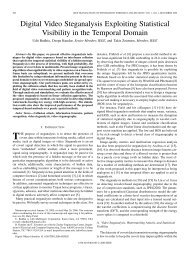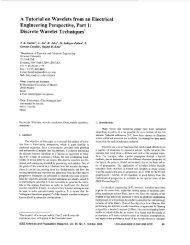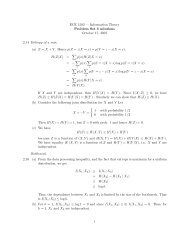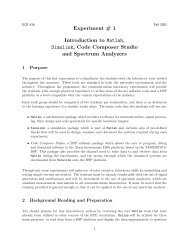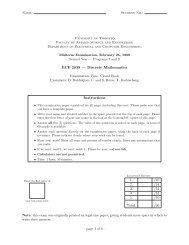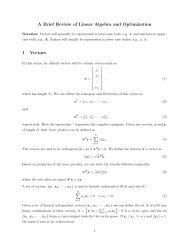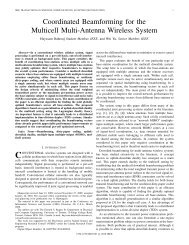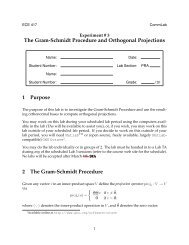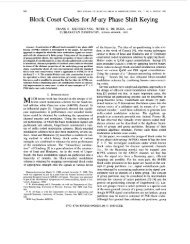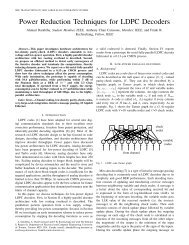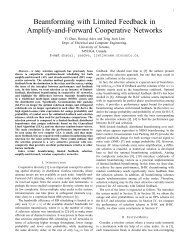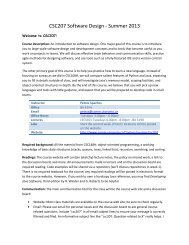Minimax Duality of Gaussian Vector Broadcast Channels
Minimax Duality of Gaussian Vector Broadcast Channels
Minimax Duality of Gaussian Vector Broadcast Channels
You also want an ePaper? Increase the reach of your titles
YUMPU automatically turns print PDFs into web optimized ePapers that Google loves.
<strong>Minimax</strong> <strong>Duality</strong> <strong>of</strong> <strong>Gaussian</strong> <strong>Vector</strong> <strong>Broadcast</strong><br />
<strong>Channels</strong><br />
Wei Yu and Tian Lan<br />
Electrical and Computer Engineering Department<br />
University <strong>of</strong> Toronto<br />
June 29, 2004<br />
Wei Yu and Tian Lan, University <strong>of</strong> Toronto
Reciprocity in <strong>Gaussian</strong> <strong>Vector</strong> <strong>Channels</strong><br />
Z 1 ∼ N (0, I) Z 2 ∼ N (0, I)<br />
X<br />
H<br />
Y<br />
Y<br />
H T<br />
X<br />
E[X T X] ≤ P<br />
E[Y T Y ] ≤ P<br />
• Capacities <strong>of</strong> the channels H and H T are the same<br />
– under the same power constraint;<br />
– even if H is not square.<br />
• Pro<strong>of</strong>: H and H T have the same singular values.<br />
Wei Yu and Tian Lan, University <strong>of</strong> Toronto 1
Reciprocity for Multi-User <strong>Channels</strong><br />
Z 1<br />
X<br />
P<br />
H Y X ′ 1<br />
1<br />
1<br />
H T 1<br />
Z 2<br />
H 2<br />
Y 2<br />
Y ′<br />
X ′ 2<br />
P<br />
H T 2<br />
Z<br />
• <strong>Duality</strong> exists between <strong>Gaussian</strong> vector MAC and BC <strong>Channels</strong><br />
(Vishwanath, Jindal, Goldsmith ’03, Viswanath, Tse ’03).<br />
• Goal <strong>of</strong> this talk: Generalization and re-interpretation <strong>of</strong> duality.<br />
Wei Yu and Tian Lan, University <strong>of</strong> Toronto 2
Uplink-Downlink <strong>Duality</strong><br />
The multiple-access channel and the broadcast channel are duals.<br />
Z 1<br />
X<br />
P<br />
H Y X ′ 1<br />
1<br />
1<br />
H T 1<br />
Z 2<br />
H 2<br />
Y 2<br />
Y ′<br />
X ′ 2<br />
P<br />
H T 2<br />
Z<br />
Previous pro<strong>of</strong>s <strong>of</strong> duality depend critically on the power constraint.<br />
Why is there duality?<br />
Wei Yu and Tian Lan, University <strong>of</strong> Toronto 3
Main Results <strong>of</strong> This Talk<br />
1. Uplink-Downlink <strong>Duality</strong> is equivalent to Lagrangian <strong>Duality</strong><br />
2. <strong>Duality</strong> generalizes beyond the sum power constraint<br />
Z 1<br />
X<br />
H Y X ′ 1<br />
1<br />
1<br />
H T 1<br />
Z 2<br />
H 2<br />
Y 2<br />
Y ′<br />
X ′ 2<br />
H T 2<br />
Z<br />
<strong>Broadcast</strong> Channel with ⇐⇒ Multiple Access Channel with<br />
Arbitrary input constraints<br />
Uncertain noise<br />
Wei Yu and Tian Lan, University <strong>of</strong> Toronto 4
Multiple Antenna <strong>Broadcast</strong> Channel<br />
• Non-degraded <strong>Gaussian</strong> vector broadcast channel:<br />
Z n<br />
W 1 ∈ 2 nR 1<br />
W K ∈ 2 nR K<br />
X n<br />
H<br />
Y n<br />
1<br />
Y n K<br />
Ŵ 1 (Y n<br />
1 )<br />
Ŵ K (Y n K )<br />
• Capacity region is solved recently.<br />
– This talk focuses on sum capacity C = max{R 1 + · · · + R K }.<br />
Wei Yu and Tian Lan, University <strong>of</strong> Toronto 5
Achievability: Writing on Dirty Paper<br />
<strong>Gaussian</strong> Channel<br />
... with Transmitter Side Information<br />
Z ∼ N (0, Sz)<br />
S ∼ N (0, Ss)<br />
Z ∼ N (0, Sz)<br />
X<br />
Y<br />
X<br />
Y<br />
C = 1 2 log |S x + S z |<br />
|S z |<br />
C = 1 2 log |S x + S z |<br />
|S z |<br />
• Capacities are the same if S is known non-causally at the transmitter.<br />
Wei Yu and Tian Lan, University <strong>of</strong> Toronto 6
Converse: Sato’s Outer Bound<br />
• <strong>Broadcast</strong> capacity does not depend on noise correlation: Sato (’78).<br />
z 1<br />
z ′ z ′ 1<br />
1<br />
x 1<br />
y 1 x 1<br />
z 2<br />
x 1 y 1 y 1<br />
= z ′ 2<br />
≤<br />
z ′ 2<br />
x 2 y 2 x 2<br />
y 2 x 2<br />
y 2<br />
} {{ }<br />
{<br />
p(z1 ) = p(z<br />
if<br />
1)<br />
′<br />
p(z 2 ) = p(z 2) ′ , not necessarily p(z 1, z 2 ) = p(z 1, ′ z 2).<br />
′<br />
• So, sum capacity C ≤ min<br />
S z<br />
max<br />
S x<br />
I(X; Y).<br />
Wei Yu and Tian Lan, University <strong>of</strong> Toronto 7
Three Achievability Pro<strong>of</strong>s<br />
1. Decision-Feedback Equalization approach (Yu, Ci<strong>of</strong>fi)<br />
• Worst-noise diagonalizes the feedforward matrix <strong>of</strong> a DFE.<br />
2. Uplink-Downlink duality approach (Viswanath, Tse)<br />
• Noise covariance is equivalent to the input constraint in dual channel.<br />
• Worst-noise decouples the inputs in the dual channel.<br />
3. Convex duality approach (Vishwanath, Jindal, Goldsmith)<br />
• Channel flipping between multiple access channel and broadcast<br />
channel.<br />
This talk: A new derivation <strong>of</strong> duality.<br />
Wei Yu and Tian Lan, University <strong>of</strong> Toronto 8
<strong>Gaussian</strong> <strong>Broadcast</strong> Channel Sum Capacity<br />
• Achievability: C ≥ max<br />
S x<br />
min<br />
S z<br />
I(X; Y).<br />
• Converse:<br />
C ≤ min<br />
S z<br />
max<br />
S x<br />
I(X; Y).<br />
• <strong>Gaussian</strong> vector broadcast channel sum capacity is therefore exactly:<br />
.<br />
C = max<br />
S x<br />
1<br />
min<br />
S z 2 log |HS xH T + S z |<br />
|S z |<br />
<strong>Duality</strong> can be derived directly from the minimax expression!<br />
Wei Yu and Tian Lan, University <strong>of</strong> Toronto 9
<strong>Minimax</strong> Optimization<br />
• <strong>Gaussian</strong> vector broadcast channel sum capacity is the solution <strong>of</strong><br />
1<br />
max min<br />
S x S z 2 log |HS xH T + S z |<br />
|S z |<br />
subject to tr(S x ) ≤ P<br />
[ ] I ⋆<br />
S z =<br />
⋆ I<br />
S x , S z ≥ 0<br />
• The minimax problem is convex in S z , concave in S x .<br />
– How to solve this minimax problem?<br />
Wei Yu and Tian Lan, University <strong>of</strong> Toronto 10
<strong>Duality</strong> through <strong>Minimax</strong><br />
• Two KKT conditions must be satisfied simultaneously:<br />
H T (HS x H T + S z ) −1 H = λI<br />
S −1<br />
z − (HS x H T + S z ) −1 =<br />
• For the moment, assume that H is invertible.<br />
[ ]<br />
Ψ1 0<br />
0 Ψ 2<br />
⇒<br />
⇒<br />
H T Sz<br />
−1 H − λI = H T ΨH<br />
H(H T ΨH + λI) −1 H T = S z<br />
• Further manipulation: ⇒ (λI) −1 − (H T ΨH + λI) −1 = S x .<br />
Wei Yu and Tian Lan, University <strong>of</strong> Toronto 11
A New <strong>Minimax</strong> <strong>Duality</strong><br />
KKT conditions lead to a new minimax problem:<br />
max<br />
S x<br />
1<br />
min<br />
S z 2 log |HS xH T + S z |<br />
|S z |<br />
min<br />
λ<br />
max<br />
Ψ<br />
1<br />
2 log |HT ΨH + λI|<br />
|λI|<br />
s.t. tr(S x ) ≤ P s.t. tr(Ψ) ≤ λP<br />
[ ]<br />
I ⋆<br />
S z =<br />
Ψ is diagonal<br />
⋆ I<br />
S x , S z ≥ 0 Ψ ≥ 0, λ ≥ 0<br />
<strong>Minimax</strong> duality is equivalent to Lagrangian duality.<br />
Wei Yu and Tian Lan, University <strong>of</strong> Toronto 12
Construct the Dual Channel<br />
KKT condition: H(H T ΨH + λI) −1 H T = S z<br />
• Define the diagonal matrix: D = Ψ/λ. trace(D) = ∑ i Ψ i/λ = P .<br />
• S z =<br />
[<br />
I ⋆<br />
⋆ I<br />
]<br />
. Thus, constraint on D: trace(D 1 ) + trace(D 2 ) ≤ P .<br />
E[X ′ 1 X′T 1 ] = D 1<br />
E[X ′ 2 X′T 2 ] = D 2<br />
trace(D 1 ) + trace(D 2 ) ≤ P<br />
X ′ 1<br />
X ′ 2<br />
H T 1<br />
H T 2<br />
Z<br />
Y ′<br />
Wei Yu and Tian Lan, University <strong>of</strong> Toronto 13
Uplink-Downlink <strong>Duality</strong><br />
Z 1<br />
X<br />
P<br />
H Y X ′ 1<br />
1<br />
1<br />
H T 1<br />
Z 2<br />
H 2<br />
Y 2<br />
Y ′<br />
X ′ 2<br />
P<br />
H T 2<br />
Z<br />
Theorem 1. Under the same power constraint, the <strong>Gaussian</strong> vector<br />
multiple-access channel and the <strong>Gaussian</strong> vector broadcast channel have<br />
the same sum capacity.<br />
New Pro<strong>of</strong>: By re-defining D = Ψ/λ, the minimization part <strong>of</strong> the<br />
minimax dual problem disappears.<br />
Wei Yu and Tian Lan, University <strong>of</strong> Toronto 14
Generalized <strong>Minimax</strong> <strong>Duality</strong><br />
Theorem 1 may be generalized to arbitrary linear constraints:<br />
max<br />
S x<br />
1<br />
min<br />
S z 2 log |HS xH T + S z |<br />
|S z |<br />
max<br />
Σ z<br />
1<br />
min<br />
Σ x 2 log |HT Σ z H + Σ x |<br />
|Σ x |<br />
s.t. tr(S x Q x ) ≤ 1 s.t. tr(Σ z Ψ z ) ≤ 1<br />
tr(S z Q z ) ≤ 1 tr(Σ x Ψ x ) ≤ 1<br />
S x , S z ≥ 0 Σ x , Σ z ≥ 0<br />
Relation: S x = λ x Ψ x S z = λ z Ψ z Σ x = λ x Q x Σ z = λ z Q z<br />
Wei Yu and Tian Lan, University <strong>of</strong> Toronto 15
Generalized Uplink-Downlink <strong>Duality</strong><br />
Z 1<br />
X<br />
H Y X ′ 1<br />
Z ′<br />
1<br />
1<br />
Z 2<br />
H 2<br />
H T 1<br />
Y 2<br />
Y ′<br />
X ′ 2<br />
H T 2<br />
tr(S x Q 1 ) ≤ P<br />
S z ∼ N (0, Q 2 ) tr(S x ′Q 2 ) ≤ P S z ′ ∼ N (0, Q 1 )<br />
Q 1 : Input constraint in BC and Noise covariance in MAC.<br />
Q 2 : Worst noise covariance in BC and Input constraint in MAC.<br />
Wei Yu and Tian Lan, University <strong>of</strong> Toronto 16
Per-Antenna Power Constrained <strong>Broadcast</strong> Channel<br />
max<br />
S x<br />
1<br />
min<br />
S z 2 log |HS xH T + S z |<br />
|S z |<br />
max<br />
Ψ<br />
min<br />
Λ<br />
1<br />
2 log |HT ΨH + Λ|<br />
|Λ|<br />
s.t. S x (i, i) ≤ P i s.t. tr(Ψ) ≤ ∑ i<br />
P i<br />
S z =<br />
[ I ⋆<br />
⋆ I<br />
]<br />
∑<br />
Λ(i, i)P i ≤ 1<br />
S x , S z ≥ 0 Λ, Ψ ≥ 0, and diagonal<br />
Theorem 2. The dual <strong>of</strong> a <strong>Gaussian</strong> vector broadcast channel with<br />
individual per-antenna power constraint is a multiple-access channel with a<br />
diagonal and linearly constrained uncertain noise.<br />
i<br />
Wei Yu and Tian Lan, University <strong>of</strong> Toronto 17
Per-Antenna Power Constrained <strong>Broadcast</strong> Channel<br />
Z 1<br />
X<br />
S x (i) ≤ P i<br />
H Y X ′ 1<br />
Z ′<br />
1<br />
1<br />
Z 2<br />
H 2<br />
H T 1<br />
Y 2<br />
Y ′<br />
X ′ 2<br />
H T 2<br />
≤∑ ∑<br />
S z (i) ∼ N (0, I) tr(S x ′) Pi Sz ′(i)P i ≤ 1<br />
In addition, this duality applies not only to the sum capacity but also<br />
the entire region.<br />
Wei Yu and Tian Lan, University <strong>of</strong> Toronto 18
Summary and Conclusions<br />
• Sum capacity <strong>of</strong> a <strong>Gaussian</strong> vector broadcast channel is:<br />
C = max<br />
S x<br />
1<br />
min<br />
S z 2 log |HS xH T + S z |<br />
|S z |<br />
• Lagrangian duality leads to uplink-downlink duality.<br />
• The dual <strong>of</strong> a broadcast channel with individual power constraint is a<br />
multiple access channel with unknown noise.<br />
• <strong>Duality</strong> can be very useful from a computational perspective.<br />
Wei Yu and Tian Lan, University <strong>of</strong> Toronto 19



